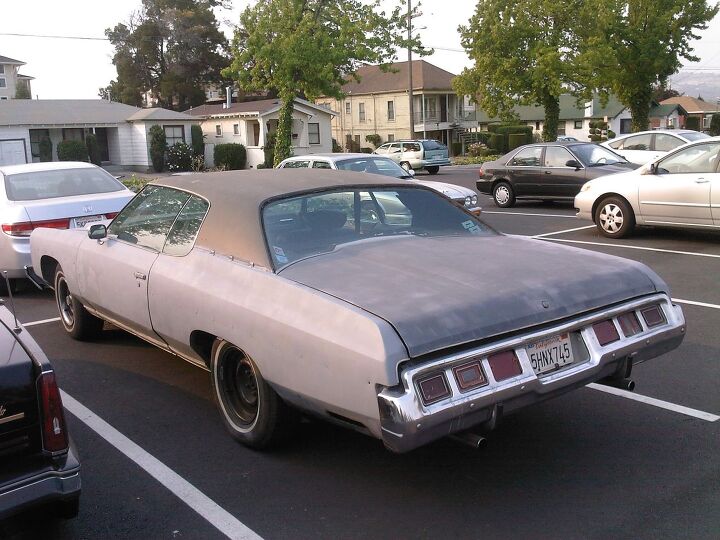Down On The Oakland Street: Daily-Driven 1973 Chevrolet Caprice

Normally, I don’t consider parking-lot photos for variations of the “interesting car parked in public” schtick, but this Caprice is special: it parks in a train-station parking lot in the roughest neighborhood in East Oakland. Every day.
Well, it parked there every day as recently as last summer, when I was still attending plenty of Oakland Athletics games and parking in the Coliseum BART lot.
The Chevy B-body of this period was a pretty decent car, with a sophisticated-for-1970s-Detroit 4-link rear suspension and reliable (if somewhat oil-leak-challenged) engines; I’ve owned a few of these and they were great daily drivers. In 1973 the big Chevy was still selling in vast quantities. How many? According to the Standard Catalog, 941,104 full-sized Chevrolets rolled off the assembly line. Interestingly, big Ford production was nearly identical, with 941,054 Galaxies, LTDs, and Custom 500s sold for the model year.
Judging by the early-70s Chevrolets you see around these days, one might get the impression that the Camaro, Corvette, and Nova were the biggest sellers. If not for the donk and lowrider crowds, even fewer Early Malaise Era Impalas and Caprices would have escaped the jaws of the Crusher… and with scrap steel now going for $250/ton, plenty of the few surviving never-got-around-to-the-project GM B-bodies now sitting in back yards and driveways are going to get eaten in the near future.

Murilee Martin is the pen name of Phil Greden, a writer who has lived in Minnesota, California, Georgia and (now) Colorado. He has toiled at copywriting, technical writing, junkmail writing, fiction writing and now automotive writing. He has owned many terrible vehicles and some good ones. He spends a great deal of time in self-service junkyards. These days, he writes for publications including Autoweek, Autoblog, Hagerty, The Truth About Cars and Capital One.
More by Murilee Martin
Latest Car Reviews
Read moreLatest Product Reviews
Read moreRecent Comments
- AZFelix Let's forego all of this dilly-dallying with autonomous cars and cut right to the chase and the only real solution.
- Zelgadis Elantra NLine in Lava Orange. I will never buy a dirty dishwater car again. I need color in my life.
- Slavuta CX5 hands down. Only trunk space, where RAV4 is better.
- Kwik_Shift_Pro4X Oof 😣 for Tesla.https://www.naturalnews.com/2024-05-03-nhtsa-probes-tesla-recall-over-autopilot-concerns.html
- Slavuta Autonomous cars can be used by terrorists.














































Comments
Join the conversation
Disc brakes became mandatory on all passenger cars in 76. They were standard equipment on the fullsize chevy starting around 71. These cars wer not mechanically stout at all, and only held up under pretty sedate driving conditions. The blocks had a pretty low nickel content, and they started burning oil between 80-100k. And you had the famous chevy cam wear problems due to the soft cams and narrow lobes and small lifters, which didn't give as much of a wear surface. And small block chevies were famous for leaking valve covers due to the 4 bolt valve cover design and thin flanges, and the seal between the timing cover and oil pan was known to leak as well. Starting in 75 they made the decks on the heads thinner and they had cracking problems. The 400 ran hot, and the heads were prone to cracking between the extra steam holes drilled in the deck surface between the combustion chambers. The use of the turbo 350 behind the 350 and most 400 engines in a car this size was a joke, and a prime example of GM's cost cutting.
If I'm not mistaken disc brakes were standard on this car starting with this body style in 71.